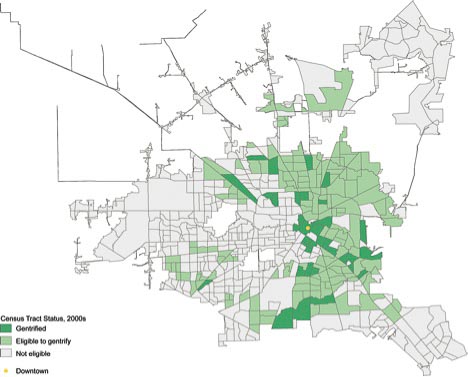Houston is doing well economically. But gentrification processes threaten to stall that progress, particularly progress in reducing racial and economic disparities. New research from the Brookings Institute on the location of jobs and recent work on gentrification from Governing magazine suggest that gentrification is pushing already disadvantaged residents farther away from jobs.
Brookings indicates that the average Houstonian saw the number of jobs within 12 miles of her/his home (the region’s median commute distance) increase by nearly 4.5 percent between 2000 and 2013. Houston was one of just 29 metropolitan areas that experienced such an increase across both its primary city and suburban areas. Despite ranking 18th out of all 29 metropolitan areas, it was the top large city by a significant margin. Houston’s positive rate is more than double those found for Washington D.C. and New York – the only other two large metropolitan areas that had increases in job proximity during this time period. The other areas that saw growth are all secondary and regional cities like Austin, TX, Boise, ID and Bakersfield, CA.
Houston’s success by this measure lies in the region’s ability to grow jobs in both central and suburban locales. The growth of the oil industry over the study period (prior to the recent slowdown) drove up job numbers in working-class suburbs along the Houston Ship Channel as well as in downtown financial and energy firms. In addition, the creation of major suburban corporate campuses, such as the one Exxon is building near the Woodlands, are ballooning the number of jobs in areas that previously had few. Such patterns corroborate the picture of Houston as a churning economic success.
But, the average does not tell it all.
While the overall rate of job proximity in the region is positive, high-poverty and majority-minority neighborhoods are facing declines in nearby jobs of -8.3% and -7.0 percent, respectively. These declines are not as steep as the corresponding rates in other cities – again suggesting some silver lining for Houston, but even being the best of those with a problem leaves the Houston metropolitan area with challenges to confront. And the decline in job proximity for these neighborhoods is most alarming because having jobs nearby is especially important for the economic outcomes of low-income and minority residents. Proximity to jobs reduces transportation costs, and increases employment prospects because knowledge of open positions increases. So, in this case, even small numbers could result in big consequences for Houston residents.
One possible explanation for the divergence between the regional rate and those for non-white and low-income Houstonians lies in demographic shifts that are a result of gentrification. Governing identified census tracts with low-income populations and low-home values as “eligible” for gentrification. And if an eligible census tract showed increases in both home values and educational attainment among residents from the top third income bracket, it was counted as gentrifying. By this measure, Houston is nearly perfectly average – only 8.6 percent of Houston’s eligible census tracts transitioned in the 1990s, but the rate increased to 18.4 percent during the 2000s. The national average values are almost identical at 8.6 percent and 20 percent, respectively.
But again, like with the average change in job proximity, while the city’s overall gentrification rate is nothing more than average, the uneven distribution of this process within the city could mean that gentrification will have a meaningful impact on the city’s disparities. Even a cursory glance at the map below suggests that gentrification will and has primarily impacted the eastern portion of the city, which is home to low-income and racial/ethnic minority residents. Redevelopment pressures that accompany gentrification could push current low-income and minority residents out of downtown neighborhoods. This is relevant for understanding changes in job proximity because numerous national studies have documented that residents displaced by gentrification are moving to areas with fewer job prospects, mainly older suburbs with low home values, far-removed from the fastest growing parts of their regions.
Census Tract Gentrification in the City of Houston, 2000-2012


